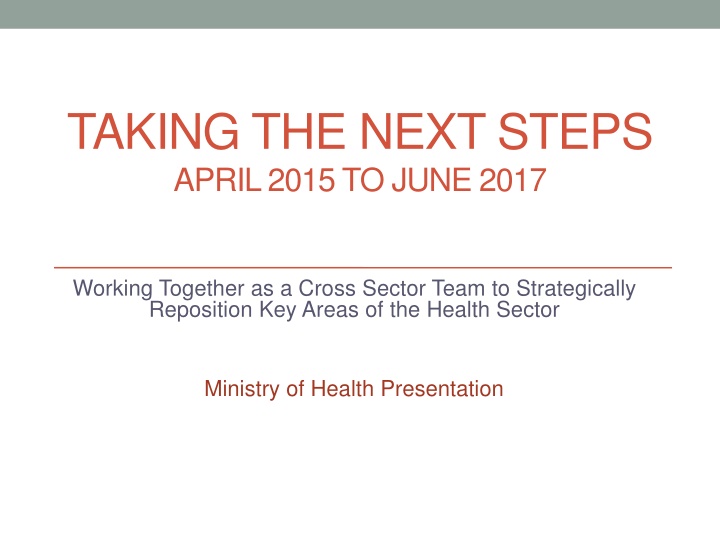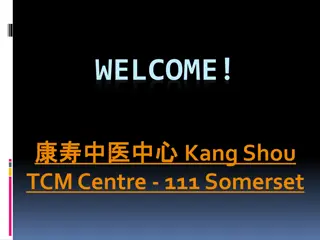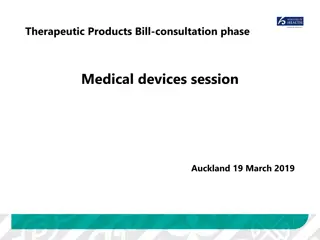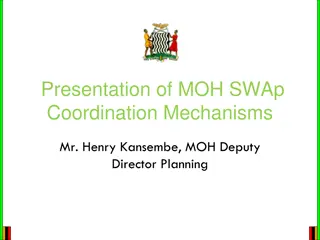
Strategically Repositioning Key Areas of the Health Sector: A Cross-Sector Team Approach
Explore the challenges and strategies involved in driving radical change in the healthcare system from April 2015 to June 2017. Discover the complexities of achieving transformative change, analyzing commitment levels, collaborating for change, and supporting continual improvement in local health sectors while driving cross-sector reforms.
Download Presentation

Please find below an Image/Link to download the presentation.
The content on the website is provided AS IS for your information and personal use only. It may not be sold, licensed, or shared on other websites without obtaining consent from the author. If you encounter any issues during the download, it is possible that the publisher has removed the file from their server.
You are allowed to download the files provided on this website for personal or commercial use, subject to the condition that they are used lawfully. All files are the property of their respective owners.
The content on the website is provided AS IS for your information and personal use only. It may not be sold, licensed, or shared on other websites without obtaining consent from the author.
E N D
Presentation Transcript
TAKING THE NEXT STEPS APRIL 2015 TO JUNE 2017 Working Together as a Cross Sector Team to Strategically Reposition Key Areas of the Health Sector Ministry of Health Presentation
2 REALIZING CHANGE Why is it so difficult to achieve radical (transformative) change?
3 The structure of the health care system
4 Can we realize change in such a large and complex system? What ability do you as an organizational actor have to make system level change happen relative to the role of other players in the organizational context and the interaction between multiple structural elements (organizational structures, hierarchies, mandate letters, budgets, agreements etc)?
5 Competing interests, pressures and dynamics?
6 Assessing commitment to change Status quo commitment of key dominant groups to prevailing institutional template in use Indifferent commitment with key dominant groups neither committed nor opposed Competitive commitment by key dominant groups to different templates Reformative commitment in which key dominant groups are against current template in use and prefer an articulated alternative (situation required for radical change)
7 Constraints to enablers - collaboration as critical enabler for change Assessing and the working with organizational culture working with the dominant organizational ideologies, discourses and interpretive schemes to make collaboration work Assessing and then working with power and status to make collaboration work Working with emergent change embedded at practice level supported by organizational and provincial levels to make collaboration work
8 Supporting continuous improvement at the local level while driving cross sector change in a few key areas
9 So how have we situated our game plan? Directional policy papers for discussion on a few key areas (an articulated possible alternative for discussion) but allowed for local and regional continuous improvement activities and initiatives Leadership Council and its Standing Committees as the engine for collaborative operational and strategic management (internal collaboration and consensus building around an alternative) Reaching out to engage key service partners ( dominant groups ) to become part of this process (external collaboration and consensus building around an alternative) Establishing a Health Sector Strategic Project Coordination Secretariat (coordination across levels focused on practice level at SDA/LHA denominator, numerator targets, measurement and evaluation) Establishing cross sector project teams linked to the key cross sector areas (collaborative effort, iterative learning emergent/prescribed)
10 What do you think? Have we hit the mark? Have we hit the mark in assessing the population needs? Have we hit the mark in focusing our efforts on those health services - primary and community care, surgical services, and rural services which are critical to the sustainability of the publicly funded health system in B.C.? Are there key pieces of information we have missed? Are there gaps in our analysis, and if so, what are they? Do you agree with the recommendations in the policy papers? What would be the top three recommendations you would see as a priority for each paper? Are there other cross system actions that you believe would provide better system wide results? If you could do anything in the current system to improve it, what would it be?
11 PROPOSED STRATEGIC AREAS OF FOCUS
12 Strategic Analysis Setting Priorities for the B.C. Health System (February 2014) B.C. Health System Strategy Implementation A Focused and Collaborative Approach (April 2014)
14 Policy Discussion Papers Delivering a Patient-centred, High Performing and Sustainable Health System - Strategic Overview The British Columbia Patient-Centered Care Framework Primary and Community Care in B.C. Future Directions for Surgical Services in B.C. Rural Health Services in B.C. A Provincial Strategy for Health Human Resources A Provincial Strategy for IM/IT (early March) A Provincial Strategy for Health Sector Funding (early March)
15 Areas Requiring Substantive Repositioning and Results as First Priority Over the coming two years the health sector needs to make substantive measurable progress on the three cross sector areas of focus: Improving the effectiveness of primary, community (including residential care), medical specialist and diagnostic and pharmacy services for patients with moderate to high complex chronic conditions, patients with cancer, patients with moderate to severe mental illness such as to significantly reduce demand on emergency departments, medical in patient bed utilization, and residential care. Significantly improving timely access to appropriate surgical treatments and procedures. Establishing a coherent and sustainable approach to delivering rural health services
17 PRIMARY AND COMMUNITY CARE significantly reduce demand on emergency departments, medical in patient bed utilization, and residential care 95% occupancy rate for large hospitals
18 Practice Level - Service Delivery Support the continued development of full service family practices that support patients across their life spans but incrementally plan for and support the establishment of team- based family practices as full service sole practitioners retire. Systematically and opportunistically establish Linked Community and Residential Care Service Practices for Older Adults with Moderate to Complex Chronic Conditions Multidisciplinary Practices Responsive Community Based Primary and Community Care Linked to Modified Assisted Living Linked to Residential Medical Short Term Stay Linked to Proactive Residential Care Placements .
19 Systematically and opportunistically establish Community and Residential Care Services Practices For Patients with Moderate to Severe Mental Illnesses and/or Substance Use Issues Multidisciplinary Practices Responsive Community Based Primary and Community Care Linked to Modified Assisted Living Linked to Residential Medical Short Term Stay Linked to Proactive Residential Care Placements Support full service practice teams with appropriate medical specialist shared care and consultations and redesigned approaches to consultant services for older people, those with chronic conditions and patients with moderate to severe mental illnesses
20 Organizational Level Operationally Based Enabling Supports Regional Health Authorities in collaboration with Divisions of Family Practice will create the enabling organizational structures and processes in support of the practice directions set out above. Increase Practice Support Change Management Increase Appropriate Access to Specialist Consultation and Support
21 Provincial Level System Based Enabling Supports Governance and Strategic Leadership Review Improve Coordination, Accountability and Implementation Complete Legislative, Regulatory and Policy Review Policy to support practice level actions Clarify The Role Of Walk In Clinics Assess and review Patient Attachment (the GP for Me) initiative Assess and review In-Patient GP Care in Metro and Urban Areas Assess and review Maternity Care Increase Appropriate Use of Telemedicine Align Home and Community Care and Residential Regulation/Policy Align Mental Health and Substance Use Regulation/Policy Significantly Strengthen Human Resources Planning and Management for the Primary and Community Care Sector Improve Data and Analytics to Support the Strategic Direction Strengthen Enabling Information Technology
22 SURGICAL SERVICES
23 Practice Level - Service Delivery Implementing a Patient and Family Centred Approach to Surgical Care Implement Practice Guidelines for Consulting with Patients on Treatment Options Encourage, Support and Implement Alternative Practice Models
24 Organizational Level Operationally Based Enabling Supports Optimize Surgical Infrastructure, Eliminating Backlogs, Ensuring Flow Based on Appropriate Timelines Optimizing Surgical Input and Supply Costs Improve Quality Monitoring and Reporting
25 Provincial Level System Based Enabling Supports Governance and Strategic Leadership Review Improve Coordination, Accountability and Implementation - PSAC Complete Legislative, Regulatory and Policy Review Optimize Wait List Management Develop and Implement a Comprehensive Performance Measurement, Reporting, and Accountability Framework for Surgical Services Implement a Surgical Health Human Resource Strategy Implement a Provincial Surgical IM/IT and Technology Strategy Align Funding and Costing Strategies to Support Policy Directions
26 RURAL HEALTH SERVICES IN B.C.
27 Practice Level - Service Delivery Population Health, Health Prevention and Wellness Primary and Community Care Organizational Level Enabling Supports to Rural Health Practice Support Teams Home Support and Residential Care in Rural Communities Access to Specialist Consultation and Support Emergency Health Services and Access to Higher Levels of Emergency Health Care: Rural Hospitals
28 Provincial Health Human Resources Planning and Management The Ministry through the Health Service Policy and Quality Assurance Division will establish public reporting, monitoring and impact/outcome assessment mechanisms for deployment starting April 2015.
29 A PROVINCIAL STRATEGY FOR HEALTH HUMAN RESOURCES
30 Establishing a Coherent Policy Framework The Ministry of Health in collaboration with Health Authorities, Colleges, the Doctors of BC and Health Unions will establish a single provincial Health Human Resource Framework that will be used to plan, link and coordinate go- forward actions and initiatives.
31 Health Human Resources Framework
32 Enabling Effective Cross Sector Health Human Resource Management Range of Actions Leadership Council will establish a Standing Committee on Health Human Resources (SCHHR) as BC s senior level HHR governance structure, reporting into Leadership Council. By September 30 2015 Health Authorities will complete an organizational change management assessment of their organization s current capacity, approaches and infrastructure By September 30 2015 Health Authorities will complete an HHRM (including physician human resource management) assessment of the organization s current capacity, approaches and infrastructure.
33 The Ministry of Health and the Health Employers Association of BC (HEABC) will complete the development of a new Integrated Health Human Resource Planning (IHHRP) tool to improve the province s HHR planning ability. Inventory of public and private post-secondary education and training programs, including clinical placement capacity. Patient-centred, culturally sensitive and inter-professional learning opportunities.
34 Enable effective transition to practice in the BC health system The SCHHR will lead the development and implementation of a leadership and management development framework for both the senior management and senior executive management of the BC health system. The SCHHR in collaboration with the Doctors of BC and health unions will round out and ensure the implementation of an inter-professional multilevel engagement strategy that builds from existing agreements and processes to support the creation of inclusive, vibrant and healthy workplaces across the health sector.
35 Specific Action Challenge Developing and Implementing a HR Deployment Methodology Linked to an Effective, Thoughtful Workplace Redesign Methodology There are difficulties with developing optimal HHR deployment strategies for models of providing care due to the scarcity and inconclusiveness of relevant research. Existing evidence on skill mix has several limitations: difficult to tease out the effect of staffing models on patient outcomes from the effect of the care intervention itself inconsistency with which the terms staff-mix and skill-mix have been conceptualized and measured.
36 Proposed HHR approach to deployment Staff Mix There is no clear guidance from the literature on what the ideal mix of health professionals might be. The most common approaches for optimizing staff mix are: adjusting the number of personnel, mixing qualifications (i.e., basic versus advanced credentials) balancing junior and senior staff members (i.e., experience), and mixing disciplines (i.e., interprofessional care teams). Skill Management Role enhancementinvolves expanding an individual s skills within their scope of practice through new, non-traditional roles Role enlargement involves expanding the scope (breadth) and diversity of the worker s skills like expanded skills that support chronic disease care
37 Professional/Inter-professional Culture Health professions have distinct cultures, including differing beliefs, language, values, customs and knowledge which impact the direction and success of patient-centred health system change. Motivation/Engagement Motivation exists when there is alignment between the health service provider s individual goals and the organization s goals: perceived alignment between goals leads to support for change perceived misalignment between goals leads to provider resistance to change. Physician Engagement engaging physicians in health system decision-making is seen as critical to successfully executing on health system strategies
38 Enabling Strategic Policy Paper Directions The SCHHR in collaboration with Health Professional Colleges, the Doctors of BC, health unions and other relevant provincial stakeholder groups, will undertake specific planning to take coordinated HR actions across different levels (practice, regional/organizational, and provincial), across the scope of service delivery (public health, community, diagnostics and pharmacy, and hospital), and across delivery settings (metro, urban, rural, remote) in support of the directions set out in the Primary and Community Care, Surgical Care and Rural Health policy papers.
39 Questions? We want now to see what you think: Have we hit the mark? Have we hit the mark in assessing the population needs, and as a result focus our efforts on those health services critical to the sustainability of the publicly funded health system: primary and community care surgical services rural services? Are there key pieces of information we have missed? Are there gaps in our analysis, and if so, what are they? Do you agree with the recommendations in the papers? What would be the top three recommendations you would see as a priority? Are there other actions that you believe would provide better system wide results? If you could do anything in the current system to improve it, what would it be?
40 Discussion


















